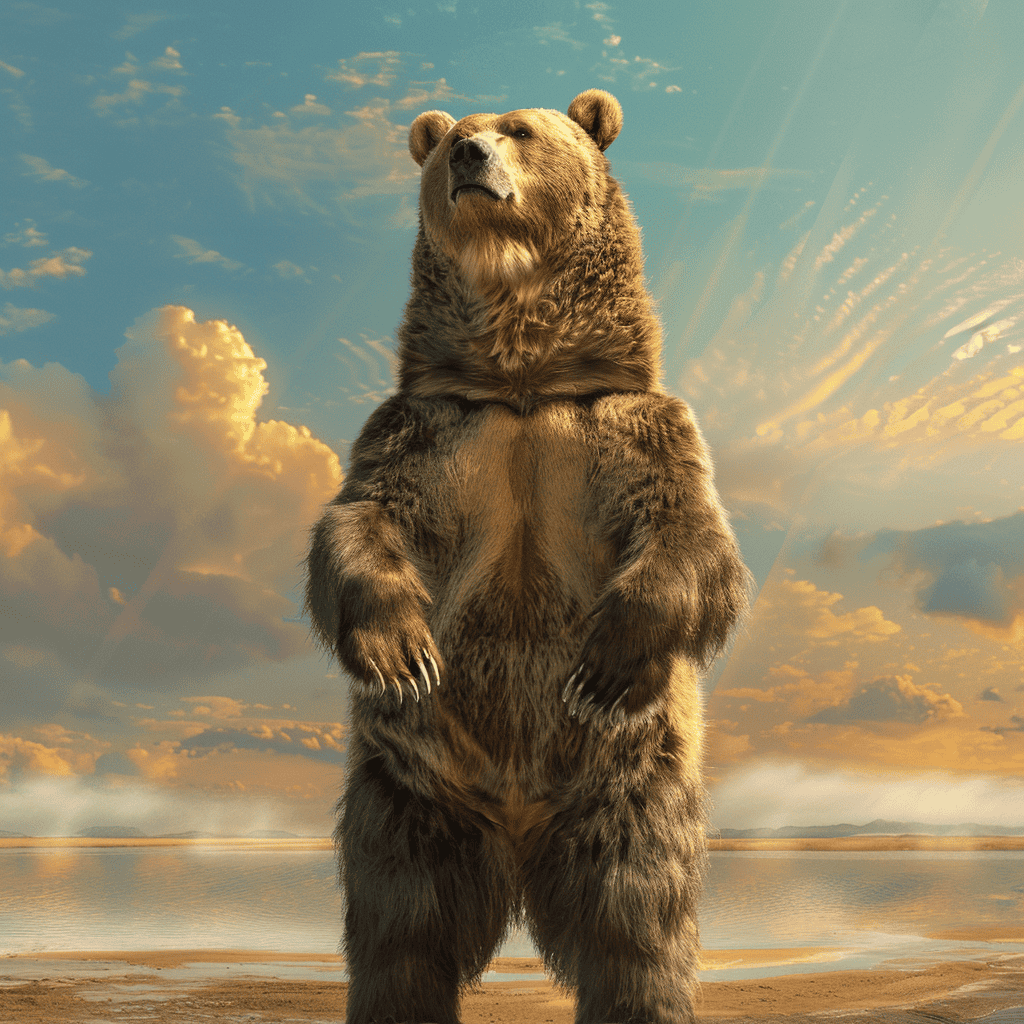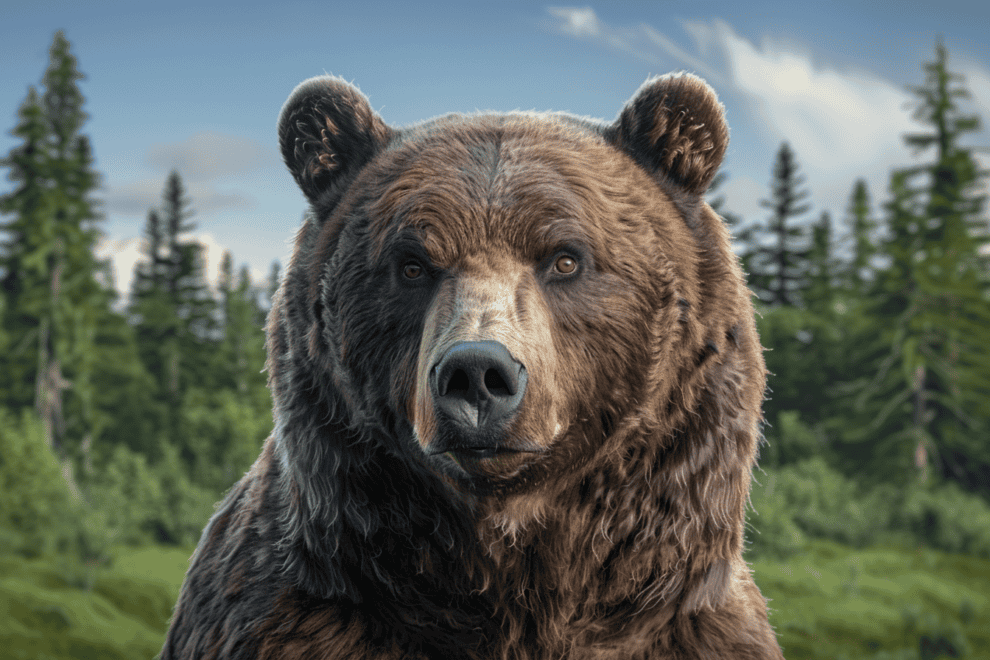Brown bears are one of the largest predators on land, and their massive size is a topic of fascination for many.
These bears are found in various parts of the world, including North America, Europe, and Asia.
Brown bears are known for their impressive size. Males weigh up to 1,500 pounds and stand almost 10 feet tall when standing upright. Meanwhile, females are typically smaller, but still impressive, weighing up to 800 pounds and standing up to 7 feet tall.

While brown bears are often compared to other bear species, such as the polar bear and the grizzly bear, they are unique in their own right.
For example, the Kodiak bear, a subspecies of the brown bear, is known for being the largest bear in the world. These bears are found only on the Kodiak Islands in Alaska and can weigh up to 1,500 pounds.
Additionally, brown bears have a distinct hump of muscle on their shoulders, which helps them dig for food and gives them the strength to take down large prey.
The World of Bears: Diversity and Distribution

Bears are fascinating creatures that can be found across the globe. They belong to the Ursidae family and are known for their massive size and ferocious strength.
There are eight species of bears in the world, each with its unique characteristics and distribution.
These include the American black bear, brown bear, polar bear, panda bear, sloth bear, sun bear, spectacled bear, and the Asiatic black bear.
They are distributed across the globe, with some species found in North America, while others are found in Asia, Europe, and South America.
The brown bear, also known as the grizzly bear, is a massive bear species that is found in North America.
They are known for their hump on their shoulders, which is made up of muscle mass.
Brown bears are found in Alaska, Canada, and the Kodiak Archipelago, where they roam freely in the wild. They can weigh up to 1,500 pounds and grow up to 10 feet in length.
Brown bears are omnivores, and their diet consists of fish, berries, and other small animals.
Polar Bears: Giants of the Arctic Circle
Polar bears are the largest land carnivores in the world and are found in the Arctic Circle.
They are adapted to the harsh Arctic environment and have a thick layer of fur and blubber to keep them warm.
Polar bears are excellent swimmers and can swim for long distances in search of food. They primarily feed on seals and other marine animals.
Adult male polar bears can weigh up to 1,500 pounds, while females weigh around 550 pounds.
How Big Do Brown Bears Get?

Brown bears are known for their massive size and strength. These fascinating creatures are one of the largest land carnivores in the world.
Adult brown bears can weigh anywhere from 200 to 1,500 pounds, depending on their subspecies, gender, and diet. Male brown bears are generally larger than females, and the Kodiak bear subspecies is the largest of all brown bears.
When it comes to size, brown bears are often compared to other bear species, such as grizzly bears and polar bears.
While grizzly bears are a subspecies of brown bears, they tend to be smaller in size, with males weighing up to 800 pounds.
In contrast, male polar bears can weigh up to 1,500 pounds, making them the largest bear species in the world.
The Record-Breaking Kodiak Bears
The Kodiak bear is a subspecies of brown bear that is native to the Kodiak Archipelago in Alaska.
These bears are known for their massive size, with males weighing up to 1,500 pounds and standing up to 10 feet tall when on their hind legs.
The largest recorded Kodiak bear weighed over 2,500 pounds, making it one of the largest land carnivores ever recorded.
Habitats and Diets: A Bear’s Life

Brown bears are terrestrial carnivores that are widely distributed across the Northern Hemisphere.
They are found in North America, Europe, and Asia, inhabiting a diverse range of landscapes, from dense forests to arid grasslands, and from coastal regions to mountainous areas.
In North America, brown bears are commonly found in Alaska, the Pacific Northwest, and the Rocky Mountains, while in Europe, they are found in Russia, Scandinavia, and the Balkans. In Asia, brown bears are found in the Himalayas, the Russian Far East, and Japan.
Brown bears are omnivores, meaning they eat both plants and animals. Their diet varies depending on the availability of food in their habitat.
In coastal regions, brown bears feed on salmon during the spawning season, while in forests, they feed on berries, nuts, and roots.
In grasslands, they feed on grasses and sedges, and in the Arctic, they feed on seals and other marine mammals.
Climate change is having a significant impact on the habitats and diets of brown bears.
As temperatures rise, the range of some brown bear populations is shifting, and their food sources are changing.
For example, in Alaska, the decline in sea ice is affecting the availability of seals, which are a primary food source for polar bears.
As a result, some brown bears are turning to alternative food sources, such as berries and grasses.
In other areas, such as the Russian Far East, the decline in salmon populations is affecting the diet of brown bears, which rely heavily on salmon during the spawning season.
Brown bears have a plantigrade gait, which means they walk with their entire foot touching the ground. This gait allows them to move quietly through their habitat and is an adaptation to their omnivorous diet.
Their teeth are also adapted to their diet, with large molars for grinding plant material and sharp canines for catching prey.
Fun Fact: Brown bears are among the largest land-based predators in the world, with males weighing up to 1,500 pounds!
Conservation and Coexistence: The Future of Brown Bears
Brown bears, like many other wildlife species, face numerous challenges in their natural habitat.
Climate change, habitat loss, and human activities such as deforestation, mining, and construction of dams, pose significant threats to the survival of these magnificent creatures.
As a result, many bear populations are declining, and some have become endangered or even extinct.
Bear-watching is an excellent way to promote awareness and respect for brown bears.
It is an eco-friendly activity that allows visitors to observe bears in their natural habitat without disturbing them.
Bear-watching tours are available in many locations worldwide, including Florida, where visitors can observe the endemic Florida black bear.
By participating in bear-watching tours, visitors can learn about the behavior, habitat, and conservation efforts for sustainable bear populations.
This type of tourism can also generate income for local communities, which can help fund conservation efforts and promote coexistence between humans and bears.
Conservation Efforts for Sustainable Bear Populations
Conservation efforts are crucial for the survival of brown bears.
Many organizations, such as Bear Trust International, work to conserve all eight species of bears, other wildlife, and habitat.
The Dakota Zoo in Clyde, North Dakota, is home to two captive brown bears, which serve as ambassadors for their wild counterparts.
Conservation efforts include habitat restoration, population monitoring, and education programs.
Many countries have implemented laws and regulations to protect bear populations, such as the Endangered Species Act in the United States.
Frequently Asked Questions

How massive can brown bears grow?
Brown bears are the largest land predators in the world. They can grow to be massive, with the largest recorded specimens weighing over 1,500 pounds. However, the average weight of a brown bear is around 600 to 900 pounds. Males are usually larger than females and can weigh up to 30% more.
In which regions can the largest brown bears be found?
The largest brown bears are typically found in coastal regions, such as Alaska and Canada. These bears are known as the coastal brown bear or the Kodiak bear. The colder climate and abundance of food sources in these regions contribute to the bears’ enormous size.
What record does the biggest brown bear hold in terms of size?
The biggest brown bear ever recorded was a Kodiak bear that weighed over 2,500 pounds. However, this record is not officially recognized, and the largest recorded bear that has been verified by scientists weighed 1,600 pounds. This bear was shot in 1960 on the shores of the Kotzebue Sound in Alaska.
Which species of bear is considered the most dangerous to humans?
While all bears have the potential to be dangerous, the brown bear is considered the most dangerous to humans. This is because of their size and strength, as well as their unpredictable nature. It is important to always exercise caution and respect when in bear country.
How do brown bears compare in size to other bear species?
Brown bears are larger than most other bear species. This includes black bears, polar bears, and sun bears. However, the largest subspecies of brown bear, the Kodiak bear, is similar in size to the polar bear.
What factors contribute to the enormous size of some brown bears?
The enormous size of some brown bears is due to a combination of genetic and environmental factors.
Brown bears in coastal regions have access to a diet rich in salmon and other protein sources, which allows them to grow larger.
Additionally, bears with larger body sizes are better able to survive in colder climates, giving them a survival advantage.









